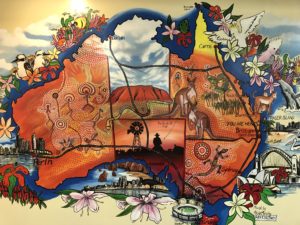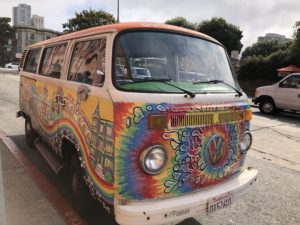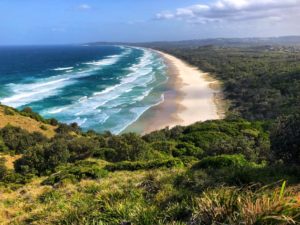
Impressions of Australia
Before leaving Australia, we took a few moments to reflect on our time in this incredibly fascinating country. Here are some of our impressions and observations:
- Au
 stralia never ceased to amaze us. Just when we thought we’d got our head around any part of the place – its land, its history, its people, its culture, its flora and fauna, etc. – we were constantly amazed to find out some other dazzling fact or figure, tidbit or perspective, scenery or vista that blew us away. Australia always surprised us with its spectacular beauty, incredible immensity, and utter quirkiness. It’s a quixotic and compelling place!
stralia never ceased to amaze us. Just when we thought we’d got our head around any part of the place – its land, its history, its people, its culture, its flora and fauna, etc. – we were constantly amazed to find out some other dazzling fact or figure, tidbit or perspective, scenery or vista that blew us away. Australia always surprised us with its spectacular beauty, incredible immensity, and utter quirkiness. It’s a quixotic and compelling place! - We met kind, welcoming, friendly people wherever we went! Aussies are so hospitable and giving. We’re forever grateful for the generosity we received from all of our hosts as well as all the other people we met along the way.
 The VW bus is alive and well in Australia!
The VW bus is alive and well in Australia!- We could listen to the Australian ‘strine’ all day long! “Strine /ˈstraɪn/ is a term coined in 1964 and subsequently used to describe a broad accent of Australian English. The term is a syncope, derived from a shortened phonetic rendition of the pronunciation of the word “Australian” in an exaggerated Broad Australian accent, drawing upon the tendency of this accent to run words together in a form of liaison.” Perhaps this lends itself to their endearing ability to shorten words or use brilliant shortcuts and crafty terms. Some of our favorites are – brekkie (breakfast); arvo (afternoon); ute (utility vehicle); servo (gas station); mozzie (mosquito); chockers (very full); Tazzie (Tasmania); Brizzie (Brisbane); Woolies (Woolworths – a popular supermarket); chook (chicken); uni (university); thingo (whatchamacallit); thongs (flip-flops); and capsicums (peppers)
- The Aussies like their sauces and spreads – vegemite, tomato sauce (ketchup), chutney, olive tapenade, BBQ sauce. Rarely would they eat anything plain.
- Australians are rugged people, a trait that is reflected in their vehicles. We often saw decked out vehicles on city streets that looked like they’d come across the harsh Australian outback, covered in rust colored dirt, extra water jugs and fuel containers strapped to the roof, snorkel air intakes and all. These are for real – they probably had just come across the outback (unlike the typical American use of large, shiny SUVs for hauling kids to soccer practice and rarely used off-road or on any other rugged terrain). Australia has a lot of rugged terrain. It doesn’t take much to get out of any urban area into the bush – just head west from any east coast urban area, and you’d probably be there in under an hour!
- Clearly, Australian culture is heavily influenced by America and Britain. However, the Aussies have forged their own way forward, even if at times, it seems as if their culture and attitudes lag behind commensurately with the distance it is away from these other major western influencers. But this is of no consequence to them. Aussies have a sort of care-free, Johnny-come-lately perspective on life. Nothing seems to faze them or upset them, whether it be extreme weather, broken farm equipment, or failed expectations – they seem to handle any of these so-called challenges in stride, and, usually, with an accompanying witty quip. Their take-it-as-it-comes attitude is right is-line with their self-reliant and forward confidence.
 Coastal Australian life revolves extensively around the ocean. Everyone and their mother-in-law surfs, or swims, and spends time at the beach. It’s a rite of passage for the majority of the population (being that the majority of the population – some 90% – lives in coastal cities).
Coastal Australian life revolves extensively around the ocean. Everyone and their mother-in-law surfs, or swims, and spends time at the beach. It’s a rite of passage for the majority of the population (being that the majority of the population – some 90% – lives in coastal cities).- So many things about Australian consumerism, by comparison, are smaller than the American counterpart. Packaging is smaller, servings sizes are smaller, and quantities are smaller. Perhaps this is more a reflection of my American ethnocentric view in which everything seems so big.
- Tattoos are really, really common; shockingly so. And big ones at that, not to be concealed – over the arms and lower legs; on the neck and back.
 We didn’t see as many kangaroos as we thought we would, or would liked to have seen. Perhaps that’s because we were mostly traveling through the most populated coast. Oh bother.
We didn’t see as many kangaroos as we thought we would, or would liked to have seen. Perhaps that’s because we were mostly traveling through the most populated coast. Oh bother.- The cost of living is very high along the east coast. The average price of a home in big cities like Sydney, but also in the smaller locales we traveled through has been in the vicinity of A$1 million. Food items tend to be anywhere from 30 to 100% higher! Bananas, for example, are A$5 per KG. Soy-based alternative cheese like I buy for Leo was A$8.99 for a package (and a smaller package at that). I bought organic corn tortillas the other day for A$7.50. Long-distance bus tickets (Premier Transit or Greyhound) for a 2-hour trip was A$35. [NOTE: As of Oct2018, the exchange rate to the US dollar was $1.39.]
- We were often woken up by bird calls that we’ve never heard before. Some extremely loud and annoying bird calls, too. Magpies, doves, blackbirds, parakeets and lorikeets. Some birds, like the magpies, had so many different types of vocalizations that we thought we were hearing different kinds of birds!
- We noticed a fair number of obese Australians, reminding us of a certain cross-section of American culture that doesn’t demonstrate much regard for healthy ways of living with respect to food and exercise, perhaps feeding on fried foods and sensationalized, polarizing media.
- Indoor shopping malls are quite popular and ubiquitous.
- We saw a large number of skin cancer clinics around the urban areas. No doubt, the savage Australian sun has something to do with that!
- The dishwasher and dryer are not as extensively used as they are in the USA.
- Rain catchment systems are used extensively for homes, schools, businesses, and many other types of businesses. A number of private properties that we visited rely primarily on rainwater to meet their household needs.


